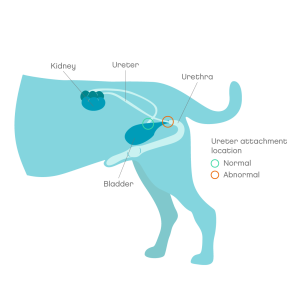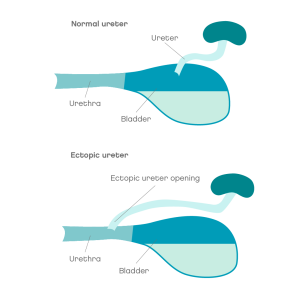Urinary incontinence is a common problem, affecting around 2% of all dogs. It is more common in middle-aged neutered females and usually responds well to treatment. Puppies can have a rare and more serious type of incontinence.
The most common cause is urinary sphincter mechanism incompetence, where the urethra becomes too weak to stop urine from dripping out of the bladder. In puppies, incontinence is often due to a birth defect called ectopic ureter. Urinary incontinence can also be caused by spinal disease or other nerve problems.
Overview
What is urinary incontinence in dogs
Why is my dog leaking urine?
Urinary incontinence is when urine leaks out without the dog realising it. This usually happens when they are lying down or resting.
In puppies with ectopic ureter, the urine coming from the kidneys is deposited beyond the bladder, which prevents normal storage and control.


In adult dogs the muscles controlling the exit to the bladder weaken over time and the position of the bladder may change.
In neutered animals, hormonal changes play a significant role in the development of incontinence.
Incontinence from spinal or nerve problems usually happens together with other symptoms, such as pain and trouble moving.
Symptoms
Symptoms of urinary incontinence in dogs
Spots or puddles of urine on their bed or where they rest
Area around vulva or penis may be wet
Puppies may dribble urine when standing and moving
Symptoms in puppies may not start until they are fully grown
Risk
Are some dogs more at risk of urinary incontinence than others?
The majority of dogs affected by this condition are neutered females
Large breeds are more commonly affected, particularly Irish Setters and Boxers
In puppies, Labradors and Golden Retrievers are more commonly affected
Diagnosis
How is urinary incontinence diagnosed in dogs?
Ectopic ureters in puppies can be difficult to diagnose. If size permits, cystoscopy may be ideal. This is when a small tube with a camera is passed through the urethra so the inside can be checked.
Other options include an ultrasound scan, a special type of x-ray or a CT scan.
In adult dogs, urinary sphincter mechanism incompetence is usually diagnosed by ruling out other causes of incontinence.
A urine test is recommended in all cases to rule out infection and disease in other organs.
Vet treatment
What is the treatment for urinary incontinence in dogs?
In puppies, the abnormal urine path must be closed. In many cases, this can be done during cystoscopy. If not, surgery is required.
In adult dogs, there are medications to improve bladder control. These tend to work well in females but not so much in males.
Some medications, like phenylpropanolamine (Propalin), directly improve the strength of the muscles around the bladder exit.
Other medications, like estriol (Incurin), replace the effects of oestrogen on the urethral muscle.
These two types of medications can be used together, and this is thought to have additional benefits.
If not responding to medication, there are surgical procedures that will reduce urine losses by re-positioning the bladder slightly (colposuspension).
It is also possible to insert an artificial urethral sphincter to control urine flow or inject material into the urethral wall to increase tension.
Home treatment
How to look after a dog with urinary incontinence
Urine can be very irritant to the skin. Until the urine leakage is resolved, it is important to prevent prolonged contact between urine and skin. Simply wiping away any wetness should be enough in most cases.
For small leaks, incontinence pads or nappies may help manage the problem in the short term. These need to be changed frequently. Look out for any irritation of the skin or vulva and stop using if this develops.
Increasing the frequency of walks may help, as a fuller bladder is more likely to leak.
Frequent washing of bedding will reduce contamination.
Applying a barrier ointment, like vaseline, to the skin around the vulva or penis may help prevent urine scald.
Never limit water intake as this could cause serious problems!
Prevention
Tips on how to prevent incontinence in dogs
There is an association between neutering and incontinence in female dogs.
An association has also been found with excess body weight.
When to worry
When to worry about your dog with incontinence
Call your vet straight away if your dog is urinating more, straining, or having accidents in the house as there may be a more serious problem.
Joii can help if:
- You’d like to discuss the ideal age for neutering your dog
- You want to talk about weight control
- You want to get feeding and diet tips








